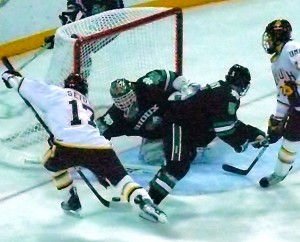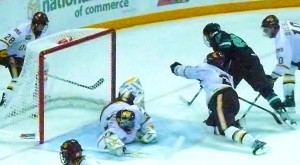Fighting Sioux alter tradition in race to WCHA lead
By John Gilbert
No more smoke and mirrors this season for the University of North Dakota hockey team. That is to say, no more mirrors. Just smoke. You could say the Fighting Sioux spent coach Dave Hakstol’s first six years reflecting on mirror-image scenarios, struggling to the Christmas break each season and then rising to become a solid contendere during repeated second-half surges. But that illusion has been shattered this season, leaving only the smoke from being red-hot through the first half.
The Sioux have raced to lead the WCHA at 11-3 at its midpoint. Kicking off the second half with an exhibition, they cruised into Duluth and christened Minnesota-Duluth’s new Amsoil Arena with a 5-0 romp over the previously No. 1 Bulldogs, leaving the Sioux 14-5-2 overall in the most impressive first half of Hakstol’s seven-year tenure. What can happen in the second half is an imposing thought to the rest of the WCHA.
“This team is no different from any other we’ve had,” said Hakstol. “We’ve been playing good hockey. We work hard, and we’ve gotten through some lineup issues. But we’re no different than in past years.”
That similarity might be called the family plan, because that’s what all of Hakstol’s teams have had in common. Totally unified, their unselfish play and teamwork is something that every team would like to have, vows to have, or pretends to have. North Dakota has it, and sets standards for team cohesiveness that other teams strive for.
This team is clearly different when it comes to results, however. In Hakstol’s previous years, North Dakota has had impressive talent, led by some big-gun scorers. Yet all of those teams struggled enough with injuries or inconsistent play through the first half of their seasons that the Sioux were jokingly accused of purposely laying low so they’d be fresh enough to respond when Hakstol would fire-up the charge from middle-of-the-pack chasing the title. That formula worked for Hakstol’s first four teams, all of which reached the Frozen Four. His fifth team won the WCHA league title, while last year’s Sioux came together to win the Broadmoor Trophy for its second championship at the Final Five playoffs.
This season, however, there are two major differences. The first is the impressive first-half success. The second is that this team, ironically, has no Zach Parise, T.J. Oshie, or Jonathan Toews — the super-scorers who led the Sioux in recent years before signing NHL contracts and departing early. Instead, the Sioux have used surprising balance.
“It’s true, we don’t have the big-name scorers this year,” Hakstol acknowledged. “But we’ve got enough guys who feel like they should score, and like they should contribute, so they do.”
The 5-0 victory at Duluth was a perfect example. A sellout crowd of 6,732 filled Amsoil Arena, and the UMD Bulldogs attacked with their favorite hard-forechecking, quick-passing style, cycling off the end boards for repeated good chances. But North Dakota played superb team defense in front of goaltender Aaron Dell, a sophomore who has displaced returning star Brad Eidsness. With considerable poise, the Sioux prevented the pesky Bulldogs from getting clean chances from the slot, or repeated chances in front.
Four different players got goals, but it was a 1-0 game until a strange circumstance in the second period. A broken pane of tempered glass in the side boards shattered with 6:25 left in the first, so the teams broke for intermission early. The final 6:25 of the period was then played, followed by the horn, a change of ends, and then the 20-minute second period. It almost seemed as though UMD was groomed for 20 minutes, but had trouble playing 26:25. After matching the Sioux chance for chance at 1-0 for 17:19 of the second period — or an actual 23:44 with the extra 6:25 — the Sioux erupted for three goals in the span of 1:14 to take command at 4-0.
Brad Malone scored two goals, one in the first period and one in the third, while Carter Rowner, Danny Kristo and Matt Frattin got one apiece in the second-period flurry. Evan Trupp set up Frattin’s goal, and Trupp also fed Malone for his second goal, shorthanded in the third. Frattin, a senior winger, has 18 goals to lead the WCHA in all-game goals. But much of the Sioux success has been ignited by the unselfish play of Trupp. Hakstol, who would rather not single out individuals for superlatives, appreciates such contributions.
“Evan has been, arguably…” said Hakstol, groping a bit to avoid overdoing it, altering the second part of the compliment. “He’s been extremely reliable.”
As for the goaltending, Hakstol said the 5-0 victory wouldn’t have been possible without Dell. “We didn’t have a lot going on the first 10 minutes,” said Hakstol. “UMD’s first line cycled the puck and gave us trouble the first 10 minutes, and they had a lot of chances to tie the game when it was 1-0. Some of the bigger plays we made were by Aaron Dell.”
It took 35 saves to blank the Bulldogs, and Dell stopped them all. “He’s given us a chance to win every time he’s played,” Hakstol said. But he stopped short of saying Dell was No. 1. Eidsness, a returning standout as a junior, was a key reason why North Dakota was the consensus preseason pick to win the WCHA. But Dell, a sophomore, has taken the No. 1 slot and stands 13-4-1 while Eidsness is 1-1-1. In 17 games, Dell’s 2.20 goals-against average and a .910 save percentage are among the league leaders.
“We’re definitely not a one-goaltender team,” added Hakstol.
Nobody typifies North Dakota’s family plan better than Chay Genoway, the 5-foot-9 dynamo on defense. Genoway went from dynamic team catalyst to the sidelines when he suffered a concussion after being checked from behind into the end boards last season. He never lost consciousness, but the concussion’s lasting effect was a never-ending string of severe headaches, every day. It was bad enough that it precluded his return to the lineup, and also prevented him from going to class. He was granted a medical redshirt to come back for a full senior season, but even then his status was uncertain, because he couldn’t work out until midsummer. Once back on skates, his return to form was a long, slow process.
“Whenever I’ve been hurt, I’ve always worked harder and harder to get back into the lineup,” said Genoway. “But with this, the less I did the better it was. At the start of the season, the game was too quick for me. Finally, it’s slowing down.”
Ironic that the player the rest of the WCHA has had trouble catching up to had become a player who had to catch up to the pace of the game. It took great determination on Genoway’s part. Hakstol was more than willing to be extra-patient with his prize defenseman, who was voted the preseason player of the year last season.
“It was an issue with our team to get Chay back,” said Hakstol. “It’s taken nearly a full two months for him to get back to form, but now he’s a toughened version of what he was last year, and it was a big boost to the team immediately when he came back. I’d say he’s nearly 100 percent now, but the best thing is, he’s going to get better and better over the next three months.”
The next three months, on top of the first three months, would put North Dakota right there in prime position for playoffs.
Comments
Tell me what you're thinking...
and oh, if you want a pic to show with your comment, go get a gravatar!





 John Gilbert is a lifetime Minnesotan and career journalist, specializing in cars and sports during and since spending 30 years at the Minneapolis Tribune, now the Star Tribune. More recently, he has continued translating the high-tech world of autos and sharing his passionate insights as a freelance writer/photographer/broadcaster. A member of the prestigious North American Car and Truck of the Year jury since 1993. John can be heard Monday-Friday from 9-11am on 610 KDAL(www.kdal610.com) on the "John Gilbert Show," and writes a column in the Duluth Reader.
John Gilbert is a lifetime Minnesotan and career journalist, specializing in cars and sports during and since spending 30 years at the Minneapolis Tribune, now the Star Tribune. More recently, he has continued translating the high-tech world of autos and sharing his passionate insights as a freelance writer/photographer/broadcaster. A member of the prestigious North American Car and Truck of the Year jury since 1993. John can be heard Monday-Friday from 9-11am on 610 KDAL(www.kdal610.com) on the "John Gilbert Show," and writes a column in the Duluth Reader.